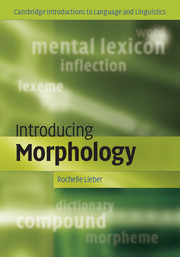Book contents
- Frontmatter
- Contents
- Preface
- The International Phonetic Alphabet
- Point and manner of articulation of English consonants and vowels
- 1 What is morphology?
- 2 Words, dictionaries, and the mental lexicon
- 3 Lexeme formation: the familiar
- 4 Productivity and creativity
- 5 Lexeme formation: further afield
- 6 Inflection
- 7 Typology
- 8 Words and sentences: the interface between morphology and syntax
- 9 Sounds and shapes: the interface between morphology and phonology
- 10 Theoretical challenges
- Glossary
- References
- Index
3 - Lexeme formation: the familiar
- Frontmatter
- Contents
- Preface
- The International Phonetic Alphabet
- Point and manner of articulation of English consonants and vowels
- 1 What is morphology?
- 2 Words, dictionaries, and the mental lexicon
- 3 Lexeme formation: the familiar
- 4 Productivity and creativity
- 5 Lexeme formation: further afield
- 6 Inflection
- 7 Typology
- 8 Words and sentences: the interface between morphology and syntax
- 9 Sounds and shapes: the interface between morphology and phonology
- 10 Theoretical challenges
- Glossary
- References
- Index
Summary
CHAPTER OUTLINE
In this chapter you will learn about common ways of creating new lexemes.
We will look at derivational affixation, considering the distinction between affixes and bases, and between free and bound bases.
We will learn how to segment words into morphemes, how to formulate word formation rules, and how to determine the structure of words.
We will consider what morphemes mean.
Beyond affixation, in this chapter we will learn about processes of compounding, conversion, and other ways of creating new words.
And you will get your first taste of morphological analysis.
KEY TERMS
derivation, affixation, compounding, conversion, coinage, blending, backformation
Introduction
Take a look at the words below:
autoclave (v.)
head bracelet (n.)
conversate (v.)
deBaathification (n.)
oversuds (v.)
McDonaldization (n.)
unwipe (v.)
Have you ever heard these words before? Can you imagine what they mean?
Chances are that you haven't heard or read them before. Nevertheless, you probably didn't have much trouble figuring out at least roughly what their meanings might be. Assuming that you know that an autoclave is a device for sterilizing instruments, the verb to autoclave probably means something like ‘to sterilize using an autoclave’. A head bracelet is probably something that goes around one's head. DeBaathification must have something to do with removing the Baath (the Iraqi political party associated with Saddam Hussein). And so on. You might not know exactly what they mean, but you can make a good guess.
- Type
- Chapter
- Information
- Introducing Morphology , pp. 31 - 58Publisher: Cambridge University PressPrint publication year: 2009



